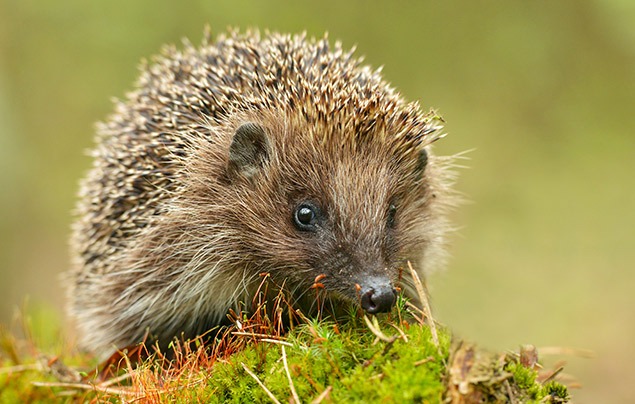Seen hedgehogs in the garden?
Check out our top tips to help these spiky critters thrive…
If you’re lucky enough to find hedgehogs in the garden, there are lots of helpful ways to help them feel at home!
The spiky little critters have declined rapidly in the UK over recent decades and getting the family together to protect your locals can be a rewarding and educational experience for everyone.
But what do hedgehogs eat? What should you feed them? Where do they live? How can you keep them safe? No fear! We’re here to help…
Feed your kids’ curiosity about the natural world with a subscription to National Geographic Kids magazine. Discover family-friendly activities for both indoor and outdoor play, and give them a head-start at school with inspiring articles that are as fun as they are educational. Find out more.
What do hedgehogs eat?
Hedgehogs love to chomp on insects, eggs, snails and even larger prey like small mice, frogs and snakes! If you have hedgehogs in your garden, you can treat them to a few extra tidbits too.
Here’s some tips for what to feed hedgehogs…
- – Leave out cat or dog food. Whether it’s tinned or biscuits, hedgehogs love our favourite pets’ food! If the hedgehog is especially young and small, soak the biscuits in water first.
- – Always leave out clean plates. Make sure to replace any food that hasn’t been eaten and wash dishes with hot and soapy water to reduce the spread of diseases.
- – Avoid foods like milk and bread. These are difficult for hedgehogs to digest and can cause health problems.
- – If your garden visitors become regulars, consider buying hedgehog food. While you might not find these snacks at supermarkets, wildlife suppliers usually sell it or can point you in the right direction.
Hedgehogs are famous for their prickly spines, but did you know that when they’re born, these strong defences are short and soft? Check out Nat Geo Kids’ fantastic facts about hedgehogs for some awe-inspiring information you can share with your kids!
How to make a hedgehog-friendly garden
Build a hedgehog hotel
Similar to bug hotels, hedgehog hotels are specially designed shelters for hedgehogs to rest in. They’re easy to create and range from fancy-looking hedgehog mansions to fun, fit-for-purpose log piles with lots of places for hogs to hide. So whether you’re a DIY lover or loather, you can still make a happy home for hedgehogs in the garden! Check out Hedgehog Street for more information.
Check hidey holes for ‘hogs
Hedgehogs enjoy hiding in hedges and longer grass. So, before you mow the lawn or trim the bushes, check for hedgehogs to avoid disturbing or hurting them! If your shed door has been open, remember to double check there’s not a hedgehog hiding in there before you lock up. And finally, around Bonfire Night, make sure you check any log piles or bonfires for hibernating hedgehogs well before you light them.
Create a wild corner!
Let native plants grow in a corner of your garden, creating a tiny wildlife haven that will support hedgehogs along with all sorts of other native creatures. Add some dead wood to give insects a home and provide somewhere safe for hibernating hedgehogs to hide.
Cover rogue holes and make sure ponds have an exit ramp
Hedgehogs can become trapped in uncovered drains and holes in your garden, so make sure these are covered or filled with earth. If you’ve got a pond, make sure you include a slope from the water to the surrounding land, so a hedgehog could safely make its way out if it fell in!
Build a hedgehog highway
If your neighbours are as welcoming to hedgehogs as you, why not suggest creating a hedgehog highway to link your gardens? These are small cut-outs, a bit like tiny cat flaps, that offer easy access through fences for hedgehogs as they travel in search of food and mates.
Avoid slug pellets and pesticides
These chemicals might be effective at protecting your plants, but they can poison hedgehogs. These creatures are natural garden pest killers, so keep them – and your plants – safe by using alternatives like crushed egg shells or coffee grounds sprinkled on the soil.
Deal with netting and litter
Hedgehogs can become tangled in litter like elastic bands, polystyrene cups and plastic rings. Make sure these are all cleaned up as quickly as possible to keep ‘hogs and other garden wildlife safe. Keep all garden and sports netting safely tied up inside when not in use.
Be a gentle giant.
If your family are lucky enough to spot a hedgehog, keep quiet and calm. While they do have spikes, you’re so much bigger and scarier to them! Observe the hogs from a distance, giving them space to go about their nocturnal activities – and if for some reason you need to handle one, make sure you use gloves and move slowly.
















LEAVE A COMMENT
THANK YOU
Your comment will be checked and approved shortly.
WELL DONE,
YOUR COMMENT
HAS BEEN ADDED!
COMMENTS
CUSTOMIZE YOUR AVATAR